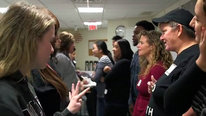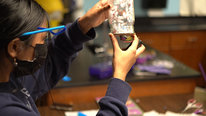- Tara Cox
- Afterschool and Family Programs Coordinator
- Presenter’s NSFRESOURCECENTERS
- The Franklin Institute
- Dale McCreedy
- Director of Gender, Adult Learning & Community Engagement
- Presenter’s NSFRESOURCECENTERS
- The Franklin Institute
Integrating Science Into Afterschool: A Three Dimensional Approach to Engaged...
NSF Awards: 1138911
2015 (see original presentation & discussion)
Grades K-6
This video will highlight best practices gleaned from current work on Integrating Science into Afterschool (“STEM 3D”). The Franklin Institute has built partnerships with city-funded out-of-school time programs in Philadelphia to offer STEM program experiences and support structures for those facilitating children’s learning afterschool. Over the past two years, STEM 3D has focused on building facilitator and program capacity in nontraditional learning environments through hands-on training sessions focused on STEM experiences.
STEM 3D trainings strategically merge pedagogical approaches to project-based learning approaches with modeling of hands-on STEM experiences in order to build the identity of OST staff as science facilitators. Embedded in the trainings are questions addressing how STEM in afterschool can impact children’s sense of identity in STEM and how we can identify ways in which underrepresented groups come to understand, value, and promote STEM content and careers.
The video will highlight our afterschool work, but will include a description of the other dimensions of the project, including how we are supporting OST staff to see themselves as a bridge for STEM learning in the community and home. Our most recent trainings have focused on ways in which facilitators can generate parent engagement in STEM in the out-of-school time setting in order to help support parents to become advocates of STEM and of STEM career pathways for their children. Each site is planning to host a Family STEM night at their sites, and the video will emphasize critical stages of the planning process.
This video will highlight best practices gleaned from current work on Integrating Science into Afterschool (“STEM 3D”). The The Franklin Institute has built partnerships with city-funded out-of-school time programs in Philadelphia to offer STEM program experiences and support structures for those facilitating children’s learning after-school. Over the past two years, STEM 3D has focused on building facilitator and program capacity in nontraditional learning environments through hands-on training sessions focused on STEM experiences.
STEM 3D trainings strategically merge pedagogical approaches to project-based learning approaches with modeling of hands-on STEM experiences in order to build the identity of OST staff as science facilitators. Embedded in the trainings are questions addressing how STEM in afterschool can impact children’s sense of identity in STEM and how we can identify ways in which underrepresented groups come to understand, value, and promote STEM content and careers.
The video will highlight our afterschool work, but will include a description of the other dimensions of the project, including how we are supporting OST staff to see themselves as a bridge for STEM learning in the community and home. Our most recent trainings have focused on ways in which facilitators can generate parent engagement in STEM in the out-of-school time setting in order to help support parents to become advocates of STEM and of STEM career pathways for their children. Each site is planning to host a Family STEM night at their sites, and the video will emphasize critical stages of the planning process.
Related Content for Integrating Science into Afterschool
-
 2018CHISPA! Children Investigating Science w/Parents&Afterschool
2018CHISPA! Children Investigating Science w/Parents&Afterschool
Cheryl Juarez
-
 2017YouthAstroNet: Exploring STEM Careers with Robot Telescopes
2017YouthAstroNet: Exploring STEM Careers with Robot Telescopes
Mary Dussault
-
 2022Collaborative Teaching Strategies for Afterschool Programs
2022Collaborative Teaching Strategies for Afterschool Programs
Fran Agnone
-
 2020Virtual coaching for afterschool educators in rural settings
2020Virtual coaching for afterschool educators in rural settings
Sue Allen
-
 2021(Un)Common Measures for OST STEM Learning
2021(Un)Common Measures for OST STEM Learning
Karen Peterson
-
 2018Explaining, Exploring, and Scientific Reasoning in Museums
2018Explaining, Exploring, and Scientific Reasoning in Museums
Maureen Callanan
-
 2022Mobile Making: An Undergraduate Led Afterschool Program
2022Mobile Making: An Undergraduate Led Afterschool Program
Edward Price
-
 2015Bridging the Gap
2015Bridging the Gap
Emily Stoeth


Amy Busey
Research Associate
Enjoyed your video! I’d love to hear more about the family engagement piece. What strategies have these trainings focused on? Are the facilitators at each site developing their own vision for what the Family STEM night (or other parent engagement activities) will look like?
Tara Cox
Afterschool and Family Programs Coordinator
Thanks Amy!
Our trainings have focused on how to promote collaborative learning between children and families and how to create a safe and curious environment for exploration. We model hands-on activities that encourage adult-child partnerships and discuss ways to set expectations for participation for parents and caregivers during Family STEM nights.
Currently each site is developing their own vision with support from the Franklin Institute. At the training, we provide examples of different models but emphasize that each event should reflect the needs of their community.
Brian Drayton
I really like the emphasis on building local capacity for further teacher learning – teachers and other educators should be their own “directors of PD”, regardless of what supports their institutions may provide. It was good, too, to hear many voices in this video!
Tara Cox
Afterschool and Family Programs Coordinator
Thanks Brian!
I wish that I could have shared even more from our facilitators since it is really them that drive the project. 3 min just flies by!
Tara
Sue Ellen McCann
Executive in Charge, Science
What are you learning about working with partners?
Tara Cox
Afterschool and Family Programs Coordinator
Hi Sue,
I think the biggest take away so far as been the importance of setting clear expectation and defining clear roles with partners. At the same time, we want to appreciate that each site is unique, and thus will have very different success and challenges. So a key to success has been the shared ownership and flexibility of our program.
Michelle Perry
Researcher
I like the idea of the program a lot. Have you encountered any challenges so far? What age or grade range does the program cover?
Tara Cox
Afterschool and Family Programs Coordinator
Hi Michelle,
Of course like any pilot program we have encountered some challenges. I think at first we assumed that all facilitators were on the same page about the concept and strategies of project-based learning since this was something that they were already doing in their after-school programs. We came to understand that everyone had a slightly different approach and that we needed to frame ours more explicitly in order to have greater fidelity of implementation.
The program targets 3rd through 5th grade.
Dilafruz Williams
I found the mention of “sense of identity” in STEM to be intriguing and wonder what theoretical framework you are using to measure this. I also appreciate that your focus is on underrepresented groups and how they come to understand, value, and promote STEM content and careers.
Further posting is closed as the event has ended.